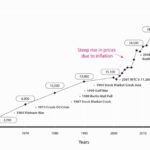The Salary Inflation Calculator is a powerful financial tool designed to assess the impact of inflation on wages and salaries, providing valuable insights into how the value of earnings has changed over time. It takes into account various factors like the Consumer Price Index (CPI) and historical inflation rates to offer precise calculations. Whether it’s 2023 or any other year, the salary inflation calculator allows users in Pakistan and the United States, among other countries, to determine how inflation has affected their income’s real worth.
The Pay Inflation Calculator by Month and Year is a powerful financial tool that allows you to determine the current value of old money with ease. By utilizing monthly and yearly inflation rates, this calculator precisely converts the purchasing power of historical money into its equivalent value today. This convenient and accurate tool is aptly called the “Money Value Converter” because it empowers users to understand the true worth of old currency, making it an invaluable resource for financial enthusiasts, collectors, and anyone curious about the impact of inflation on their money over time. Whether you’re interested in historical finances or want to make informed financial decisions, the Money Value Converter is the ideal solution for exploring the current value of old money.
Reverse & Future Salary Inflation Calculator
With the salary increase calculator inflation, users can perform both forward and reverse calculations with comparisons. While the forward calculation helps individuals predict the future value of their earnings, the reverse inflation calculator enables them to compare past salaries in today's terms. This feature proves especially useful for financial planning, budgeting, and negotiating better wages. Whether one wants to calculate salary inflation for 2020 or any other year, this tool provides accurate data for informed decision-making. Moreover, it is not limited to annual incomes; the calculator can also be utilized as an hourly wage inflation calculator for more detailed assessments.
By utilizing the salary inflation calculator, individuals can determine the current value of old money by accounting for inflation over specific periods. This functionality aids in comprehending the purchasing power of money from the past relative to present times. Whether in USD or any other currency, this calculator offers a reliable way to understand the effects of inflation on salaries, empowering users to plan their financial futures more effectively.
How to Calculate the Salary Inflation Rate?
Calculating the salary inflation rate can be done using the Salary Inflation Calculator tool (Calcinflation) provided above. The tool allows you to calculate the inflation-adjusted salary over a specific period by taking into account the starting and ending dates, the current salary or hourly rate, and the general inflation rate.
Here's how to calculate the salary inflation rate using the tool:
- Enter the Current Salary or Hourly Rate: Start by entering your current salary or hourly rate in the provided input box. Make sure to enter the amount without any commas.
- Select Starting and Ending Dates: Choose the starting date and ending date for the period you want to calculate the inflation rate for. The tool allows you to select the year and month.
- Click on the "Calculate" Button: After providing the necessary details, click on the "Calculate" button. The tool will then calculate the inflation-adjusted salary and display it along with the inflation rate.
- Interpreting the Results: The tool will show you the adjusted salary, which is the estimated salary you would need to maintain the same purchasing power given the inflation rate over the chosen period. It will also display the inflation rate, which indicates the percentage change in prices over the selected period.
Keep in mind that the inflation rate is an estimate based on the provided information and historical inflation data. Actual inflation rates may vary over time and across regions.
Calculating salary inflation rates manually requires access to historical consumer price index (CPI) data for the specific region or country. The formula for calculating the inflation rate based on the CPI is as follows:
Inflation Rate = ((CPI₂ - CPI₁) / CPI₁) * 100
Where: CPI₁ is the Consumer Price Index at the starting date. CPI₂ is the Consumer Price Index at the ending date.
You can find the historical CPI data from official government websites or economic databases. Once you have the CPI values for the starting and ending dates, you can use the formula to calculate the inflation rate.
Please note that the accuracy of the inflation rate calculation depends on the quality and reliability of the CPI data used.
For the United States, you can find historical CPI data from the U.S. Bureau of Labor Statistics (BLS) or other reputable economic sources. Using the CPI data for specific periods, you can apply the inflation rate formula to calculate the inflation-adjusted salary in the U.S.

It's important to stay informed about inflation rates, as they can impact the purchasing power of salaries and wages, affecting the overall economy and cost of living.
The Inflation Rate Formula
The Inflation Rate Formula is a mathematical equation used to calculate the percentage change in the price level of goods and services over a specific period, typically a year. It is a crucial economic indicator that helps measure the rate of inflation in an economy. Inflation refers to the general increase in prices, leading to a decrease in the purchasing power of money.
The formula for calculating the inflation rate is as follows:
Inflation Rate = [(Current Price Index - Base Price Index) / Base Price Index] * 100
Where:
- Current Price Index: This represents the average price level of goods and services in the current period. It is usually represented by a consumer price index (CPI) or producer price index (PPI), which measures the changes in the prices of a basket of goods and services commonly purchased by households or producers.
- Base Price Index: This is the average price level of goods and services in the base or reference period. It serves as the starting point for comparison and is usually assigned a value of 100.
The Inflation Rate Formula calculates the percentage change between the current price index and the base price index, expressed as a percentage. A positive inflation rate indicates an increase in prices (inflation), while a negative inflation rate indicates a decrease in prices (deflation).
For example, let's consider a hypothetical scenario where the current price index is 120 and the base price index is 100. Using the formula:
Inflation Rate = [(120 - 100) / 100] * 100 = (20 / 100) * 100 = 20%
In this case, the inflation rate is 20%, indicating that the general price level has increased by 20% compared to the base period.
The Inflation Rate Formula is widely used by governments, central banks, economists, and financial analysts to monitor and analyze changes in price levels and the overall health of an economy. It helps in making informed monetary and fiscal policy decisions, understanding the impact on purchasing power, and making adjustments to income, investments, and other financial decisions to cope with inflationary pressures. Additionally, it is a critical component in calculating real rates of return on investments and wages, as it adjusts nominal values for the effects of inflation.
Salary Inflation Adjustment 2023
Salary Inflation Adjustment 2023 refers to the annual process of increasing salaries or wages to account for the effects of inflation during the year 2023. Inflation is the general rise in prices of goods and services over time, leading to a decrease in the purchasing power of money. As the cost of living increases, employees' salaries need to be adjusted to maintain their real value and ensure their compensation keeps up with the rising expenses.
Employers typically conduct salary inflation adjustments to help employees cope with the rising costs of living and retain a competitive compensation package. Without such adjustments, employees' purchasing power may erode, leading to decreased standards of living and potential dissatisfaction.
The specific salary inflation adjustment for 2023 would depend on various factors, including the country's overall economic performance, inflation rate, and industry-specific trends. Economies with higher inflation rates may require larger salary increases to maintain employees' purchasing power.
It's essential for companies and organizations to conduct thorough market research and analyze economic indicators to determine an appropriate salary inflation adjustment for their workforce. This process ensures that the adjustment aligns with industry standards and regional economic conditions.
Moreover, salary inflation adjustment considerations may vary based on factors like job role, employee performance, and company budget constraints. Human resources departments and compensation committees play a significant role in designing and implementing fair and reasonable salary inflation adjustments.
Read More Updates:
- Real Wage Vs Nominal Wage Differences
- How to Calculate Salary Increase Based on Inflation?
- How to reduce inflation as a student?
- How much should salary increase with inflation?
- Value of 1 lakh After 5 to 30 Years
Key Features and Functionality:
- Inflation Rate Calculation: The calculator employs historical inflation data, sourced from reputable indices, to calculate the inflation rate for a specific period.
- Input Data: Users input their current salary or wage amount and the year when they started receiving it.
- Accurate Adjustments: By factoring in the inflation rate, the calculator provides an adjusted salary amount that represents the wage's real value in today's dollars.
- Time Travel for Wages: The tool enables users to "time travel" and compare the purchasing power of their salary between the starting year and the present.
- Visualization: It often accompanies an interactive chart that graphically illustrates the salary's growth or decline in real terms over the selected time frame.
- Future Projections: Some advanced calculators can project salary adjustments into the future, allowing users to anticipate the impact of inflation on their earnings.
Benefits and Uses:
- Financial Planning: The Salary Inflation Calculator aids individuals in planning for their financial future, considering the effects of inflation on their earning potential.
- Salary Negotiations: Employees can use the calculator to understand the real value of a salary offer and negotiate more effectively with employers.
- Budgeting: The tool helps individuals adjust their budgeting and lifestyle choices to maintain their standard of living amidst changing economic conditions.
- Long-Term Investments: Investors can use the calculator to assess the performance of investments and ensure they outpace inflation to preserve purchasing power.
- Economic Analysis: Researchers and economists can utilize the data generated by the calculator for various economic analyses and reports.
The wage Inflation Calculator is an indispensable asset for anyone seeking a clear understanding of their income's true worth in the face of inflationary pressures. With its ability to provide reliable, data-driven insights, individuals and professionals can make informed financial decisions, secure their financial future, and navigate the ever-changing economic landscape with confidence.
U.S. Inflation Rate - Historical Data
| Year | Inflation Rate (%) | Annual Change |
|---|---|---|
| 2021 | 4.70% | 3.46% |
| 2020 | 1.23% | -0.58% |
| 2019 | 1.81% | -0.63% |
| 2018 | 2.44% | 0.31% |
| 2017 | 2.13% | 0.87% |
| 2016 | 1.26% | 1.14% |
| 2015 | 0.12% | -1.50% |
| 2014 | 1.62% | 0.16% |
| 2013 | 1.46% | -0.60% |
| 2012 | 2.07% | -1.09% |
| 2011 | 3.16% | 1.52% |
| 2010 | 1.64% | 2.00% |
| 2009 | -0.36% | -4.19% |
| 2008 | 3.84% | 0.99% |
| 2007 | 2.85% | -0.37% |
| 2006 | 3.23% | -0.17% |
| 2005 | 3.39% | 0.72% |
| 2004 | 2.68% | 0.41% |
| 2003 | 2.27% | 0.68% |
| 2002 | 1.59% | -1.24% |
| 2001 | 2.83% | -0.55% |
| 2000 | 3.38% | 1.19% |
| 1999 | 2.19% | 0.64% |
| 1998 | 1.55% | -0.79% |
| 1997 | 2.34% | -0.59% |
| 1996 | 2.93% | 0.13% |
| 1995 | 2.81% | 0.20% |
| 1994 | 2.61% | -0.34% |
| 1993 | 2.95% | -0.08% |
| 1992 | 3.03% | -1.21% |
| 1991 | 4.24% | -1.16% |
| 1990 | 5.40% | 0.57% |
| 1989 | 4.83% | 0.75% |
| 1988 | 4.08% | 0.41% |
| 1987 | 3.66% | 1.77% |
| 1986 | 1.90% | -1.65% |
| 1985 | 3.55% | -0.75% |
| 1984 | 4.30% | 1.09% |
| 1983 | 3.21% | -2.92% |
| 1982 | 6.13% | -4.20% |
| 1981 | 10.33% | -3.21% |
| 1980 | 13.55% | 2.29% |
| 1979 | 11.25% | 3.62% |
| 1978 | 7.63% | 1.13% |
| 1977 | 6.50% | 0.76% |
| 1976 | 5.74% | -3.40% |
| 1975 | 9.14% | -1.91% |
| 1974 | 11.05% | 4.88% |
| 1973 | 6.18% | 2.91% |
| 1972 | 3.27% | -1.02% |
| 1971 | 4.29% | -1.55% |
| 1970 | 5.84% | 0.38% |
| 1969 | 5.46% | 1.19% |
| 1968 | 4.27% | 1.50% |
| 1967 | 2.77% | -0.24% |
| 1966 | 3.02% | 1.43% |
| 1965 | 1.59% | 0.31% |
| 1964 | 1.28% | 0.04% |
| 1963 | 1.24% | 0.04% |
| 1962 | 1.20% | 0.13% |
| 1961 | 1.07% | -0.39% |
| 1960 | 1.46% | -0.39% |
CPI Inflation Calculator
What: A CPI Inflation Calculator is a tool used to calculate the impact of inflation on the purchasing power of money over time. "CPI" stands for Consumer Price Index, which is a measure of the average change over time in the prices paid by urban consumers for a market basket of consumer goods and services.
Why: Inflation erodes the value of money over time, meaning that the same amount of money will buy fewer goods and services in the future than it does today. Understanding the impact of inflation is important for individuals, businesses, and policymakers to make informed financial decisions and adjust budgets and investments accordingly.
How: The CPI Inflation Calculator typically requires you to input the starting year, the starting amount of money or cost, and the ending year. It uses historical CPI data for the specified years to calculate the equivalent value of the initial amount in terms of purchasing power in the ending year. The calculator accounts for the percentage change in the CPI between the two years to estimate the effect of inflation.
Future Inflation Calculator
What: A Future Inflation Calculator is a tool used to estimate the future value of money or the future cost of goods and services based on projected inflation rates. It helps individuals and businesses plan for inflation and make decisions regarding savings, investments, pricing, and budgeting.
Why: Future inflation is uncertain, and it can have a significant impact on long-term financial planning. By using a Inflation Calculator, individuals and businesses can understand how inflation may affect their financial goals and adjust their strategies accordingly.
How: The Future Inflation Calculator typically requires you to input the current amount of money or cost, the number of years into the future you want to project, and the assumed or expected inflation rate. The calculator applies the inflation rate to the initial amount over the specified years to estimate its future value or cost.
Reverse Inflation Calculator
What: A Reverse Inflation Calculator is a tool used to determine the historical equivalent value of a given amount of money or cost in terms of today's purchasing power. It helps to understand the past value of money adjusted for inflation.
Why: Understanding the historical value of money is essential for comparing purchasing power and economic conditions over different time periods. The Reverse Inflation Calculator helps put historical prices and wages into perspective, allowing for better comparisons.
How: The Reverse Inflation Calculator requires you to input the historical amount of money or cost, the year when the amount was applicable, and the current year. The calculator uses historical CPI data to adjust the initial amount for inflation and determine its equivalent value in terms of today's purchasing power.
These inflation calculators are valuable tools for personal finance management, economic analysis, and historical research. They provide insights into how inflation affects financial decisions and the relative value of money across different time frames. Users can make better-informed choices and plan for the future by using these calculators to account for the impact of inflation.
What Is Inflation and How Does It Work?
Inflation is a fundamental economic concept that refers to the general increase in prices of goods and services over time, leading to a decrease in the purchasing power of money. It is measured by the inflation rate, which indicates the percentage change in the overall price level in a given period, usually a year. Several factors contribute to inflation, including changes in consumer demand, production costs, government policies, and monetary factors like interest rates and money supply.
Inflation can have both positive and negative effects on the economy. A moderate level of inflation is generally considered healthy for economic growth as it encourages spending and investment. On the other hand, high or hyperinflation can erode the value of money rapidly, leading to instability, decreased consumer confidence, and challenges for businesses and individuals to plan for the future.
The Purpose of the Inflation Calculator
The Inflation Calculator serves as a valuable financial tool to assess the impact of inflation on various aspects of personal finance, including savings, investments, and salaries. Its primary purpose is to provide individuals with the ability to translate past financial figures into present-day values, accounting for changes in the purchasing power of money due to inflation.
By using historical inflation data and advanced algorithms, the calculator allows users to compare the worth of money across different time periods. This empowers individuals to make more informed decisions regarding financial planning, retirement savings, and long-term investments. Moreover, the calculator helps users understand how inflation affects their standard of living over time, ensuring better financial preparedness and goal setting.
What is Inflation and How Does It Affect My Salary?
Inflation has a direct impact on salaries and wages. As the general price level rises, the cost of living increases, reducing the real value of salaries and wages. Suppose an individual's salary remains constant while inflation rises; in that case, the purchasing power of their income decreases, making it harder to maintain the same standard of living.
The Inflation Calculator for salary provides valuable insights into how an individual's earnings have changed in real terms over different time periods. By entering historical salary data and selecting specific years, users can understand how inflation has influenced their income's actual value.
This knowledge is particularly crucial for long-term financial planning. For instance, understanding how inflation affects salary growth can help individuals negotiate better wages, plan for retirement, and make well-informed decisions about investments and saving strategies. By staying informed about inflation's impact, individuals can proactively adjust their financial goals and maintain financial stability in an ever-changing economic landscape.
Following Term Need To Understand
Inflation Calculator:
An inflation calculator is a pivotal tool, especially for economists and financial professionals, that showcases the erosion of money's value over time due to inflation. By using historical data and a base year as a reference, users can convert amounts to see what they would be equivalent to in another time frame, thus understanding the real-time effects of inflation on purchasing power.
Inflation Rate:
The cornerstone of macroeconomic analysis, the inflation rate is an indicator of the health of an economy. It represents the yearly percentage change in general prices for goods and services. While moderate inflation is seen as a sign of a growing economy, either extreme (too high or negative) can be problematic. For consumers, it affects how their purchasing power changes from one year to the next.
Consumer Price Index (CPI):
Representing the benchmark for inflation measurement, the CPI assesses the average price change over time of a fixed basket of goods and services, typically consumed by households. Economists and policymakers closely watch the CPI to gauge inflationary pressures and steer monetary decisions.
Cost of Living:
Beyond just numbers, the cost of living provides a tangible feel of what it means to live in a particular region or country. It encompasses all basic expenses—housing, food, transportation, healthcare, and more. Regions with a high cost of living often see a simultaneous demand for higher wages.
Purchasing Power:
This concept essentially zeroes in on what your money can buy. The crux of purchasing power is its inverse relationship with inflation: as inflation rises, every dollar or euro in your pocket buys a little less than before.
Real Wage:
In the vast landscape of earnings, the real wage shines a light on what an individual can truly afford. Adjusted for inflation, it gives a snapshot of one’s actual financial health. If wages don't keep up with inflation, even with a raise, you might be earning less in real terms.
Deflation:
Often misunderstood as a boon, deflation is the decline in prices for goods and services. While it might seem like a good thing initially, persistent deflation can lead to an economic trap where consumers and businesses delay spending and investments, leading to economic stagnation.
Hyperinflation:
The extreme end of the inflation spectrum, hyperinflation is a chaotic economic scenario where prices rise exponentially, often rendering a currency worthless. It’s more than just high inflation—it's a breakdown in the trust of a nation's currency, often accompanied by social and political upheavals.
Measuring Inflation:
While the concept of inflation is straightforward, its measurement is intricate. Apart from the widely accepted CPI, there are various other indices and methods, each offering a slightly different perspective, ensuring policymakers have a holistic view.
Inflation Impact:
Inflation isn't just an economist's concern—it touches everyone. From eroding the value of savings to influencing business strategies, its ripple effects are manifold. High inflation can deter investors, disrupt savings, and put pressure on interest and exchange rates.
Inflation Forecasting:
This is the art and science of predicting future inflation trends. Essential for financial planning, investment strategies, and government policies, accurate forecasts guide interest rate decisions, bond market movements, and more. It combines analytical models, historical patterns, and economic indicators.
Frequently Asked Question
What is the impact of inflation on a salaried person?
Inflation affects a salaried person's purchasing power, reducing the value of their money over time. As the general price level of goods and services rises, the same amount of money buys fewer goods, leading to a decrease in the real value of salaries. This means that even with salary increases, if they do not keep up with inflation, the salaried person's standard of living may decline, and it can become challenging to afford the same level of expenses.
What is a typical salary increase for a promotion?
Salary increases for promotions can vary depending on the company's policies, industry standards, and the significance of the promotion. On average, a typical salary increase for a promotion can range from 5% to 20% of the current salary. However, this can vary widely, and some promotions may come with more substantial salary raises, especially for higher-level positions or positions with increased responsibilities.
How do you request a salary increase due to inflation?
Requesting a salary increase due to inflation requires careful preparation and communication with your employer. Here are some steps to follow:
a. Research: Gather data on the current inflation rate and its impact on living expenses in your area.
b. Prepare a Case: Highlight your contributions to the company, achievements, and increased responsibilities. Show how inflation has affected your purchasing power and why a salary adjustment is justified.
c. Schedule a Meeting: Request a meeting with your manager or HR representative to discuss your salary concerns.
d. Be Professional: Present your case professionally and calmly, and be open to negotiation.
e. Follow Up: If the request is not immediately approved, ask for feedback and inquire about the possibility of a future review.
What is the salary increment in Budget 2023?
The salary increment in Budget 2023 can vary depending on the specific country, region, and economic conditions. Government budgets typically outline changes in various sectors, including public sector salaries. To get accurate and up-to-date information on the salary increment in Budget 2023, it is essential to refer to the official government announcements and documents related to the specific country or region in question. These budget documents will provide detailed information on salary adjustments and other economic measures for the upcoming year.
What if my employer doesn't provide an annual inflation salary increase?
If your employer doesn't offer an annual inflation salary increase, it's essential to understand your rights and negotiate your compensation effectively. Consider discussing the matter with your HR department or supervisor, highlighting the impact of inflation on your purchasing power over time. You can also explore other options such as performance-based bonuses, promotions, or seeking opportunities with companies that offer competitive salary adjustments.
What is the salary increment in Budget 2023?
The salary increment in Budget 2023 varies depending on government policies, economic conditions, and the specific country's budget allocations. It's advisable to refer to official government sources or financial news outlets for the most accurate and up-to-date information regarding the salary increment in Budget 2023.
What is the US wage growth for 2023?
The US wage growth for 2023 is influenced by several factors, including inflation, economic growth, labor market conditions, and government policies. To obtain precise data on US wage growth for 2023, it is recommended to refer to reputable economic research institutions, government reports, or financial publications that analyze and report on employment and wage trends.
How much are wages growing in the US?
The rate at which wages are growing in the US can vary based on industry, job market conditions, and regional economic factors. To stay informed about the current wage growth trends in the US, you can monitor official labor market reports, economic indicators, and research studies conducted by reputable organizations. Additionally, consulting with human resources professionals or industry experts can provide valuable insights into wage growth trends in specific sectors or regions.
What is the formula for inflation return?
The formula for inflation return is calculated using the following equation:
Inflation Return = ((Ending Value - Starting Value) / Starting Value) * 100
What is the value of 1 lakh after 20 years?
The future value of 1 lakh after 20 years depends on the inflation rate and the compounding period. To calculate it accurately, you can use the formula for compound interest or utilize online financial calculators that take inflation into account.
How to calculate inflation rate using a calculator?
To calculate the inflation rate, you will need the current price (CP) of a product or service and its price in the past (PP). Use the following formula:
Inflation Rate = ((CP - PP) / PP) * 100
With an inflation rate calculator, you can simply input the required values to get the result instantly.
How much is $1 dollar in 1955 worth in 2023?
To determine the worth of $1 dollar in 1955 in terms of 2023's purchasing power, you need to adjust it for inflation. You can use an inflation calculator or refer to historical inflation data to calculate the equivalent value of $1 dollar in 2023. This will give you an idea of how inflation has affected the dollar's value over time.






![Salary Inflation Calculator Pakistan [2023] - CalcInflation](http://calcinflation.com/wp-content/uploads/2023/08/Salary-Inflation-Calculator-Pakistan-min-1024x576.png)











